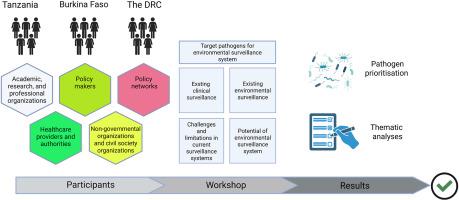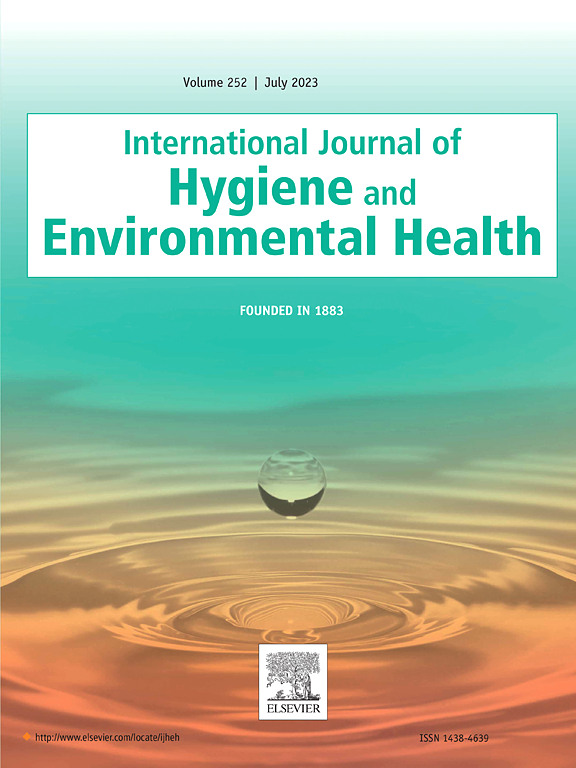通过撒哈拉以南非洲的环境监测加强病原体和抗微生物药物耐药性监测:利益攸关方的观点
IF 4.4
2区 医学
Q1 INFECTIOUS DISEASES
International journal of hygiene and environmental health
Pub Date : 2025-09-01
DOI:10.1016/j.ijheh.2025.114651
引用次数: 0
摘要
废水和环境监测(WES)是监测水生、呼吸道和抗微生物药物耐药性(AMR)病原体的出现和趋势的新兴工具。在许多病原体监测系统有限的发展中国家,WES可以补充和支持现有的监测工作,并加强病原体监测能力。本研究探索了WES的重点病原体,并评估了坦桑尼亚、布基纳法索和刚果民主共和国(DRC)现有的监测做法,包括WES。在每个国家都举办了国家混合讲习班,吸引来自学术界、研究、政策、环境卫生和保健等不同领域的利益攸关方参加。通过Webropol平台和Mentimeter进行两项结构化调查。. com,在每次讲习班期间进行,以收集有关现有临床和环境监测系统以及潜在WES目标的信息。调查结果按主题进行分析,每个主题都使用文献中的科学证据进行彻底评估。WES鉴定的主要病原体包括水媒病原体,如脊髓灰质炎病毒、伤寒沙门氏菌、霍乱弧菌,以及非水媒病原体,如甲型B型流感、SARS-CoV-2、麻疹、风疹。WES的高优先抗菌素耐药性靶点包括耐多药结核分枝杆菌、沙门氏菌和产esbl的大肠杆菌。发现这三个国家都使用集中电子系统收集临床数据,而WES仍然有限,而且主要局限于基于项目的应用。答复者强调,采用WES可加强监测系统,追踪传播的病原体,并保障人类、动物和环境健康。因此,WES可在预防水传播疾病暴发、保护饮用水源和支持综合风险管理方面发挥关键作用,有助于实现各项联合国可持续发展目标。本文章由计算机程序翻译,如有差异,请以英文原文为准。

Strengthening pathogen and antimicrobial resistance surveillance through environmental monitoring in sub-Saharan Africa: stakeholder perspectives
Wastewater and environmental surveillance (WES) is an emerging tool for monitoring emergence and trends of waterborne, respiratory, and antimicrobial-resistant (AMR) pathogens. In many developing countries with limited pathogen surveillance systems, WES can complement and support existing monitoring efforts and strengthen pathogen surveillance capacity. This study explored priority pathogens for WES and assessed existing surveillance practices, including WES, in Tanzania, Burkina Faso, and the Democratic Republic of the Congo (DRC). National hybrid workshops were held in each country, engaging stakeholders from diverse fields, including academia, research, policy, environmental health, and healthcare. Two structured surveys, administered via Webropol platform and Mentimeter. com, were conducted during each workshop to gather information on existing clinical and environmental surveillance systems and potential WES targets. Survey responses were analysed thematically, with each theme thoroughly evaluated using scientific evidence from the literature. Key pathogens identified for WES included waterborne pathogens, such as poliovirus, Salmonella Typhi, Vibrio cholerae, and non-waterborne pathogens, such as influenza A&B, SARS-CoV-2, measles, rubella. High-priority AMR targets for WES included multidrug-resistant Mycobacterium tuberculosis, Salmonella spp., and ESBL-producing E. coli. All three countries were found to use centralised electronic systems for clinical data collection, while WES was still limited and largely confined to project-based applications. Respondents highlighted that adopting WES could enhance surveillance systems, track circulating pathogens, and safeguard human, animal, and environmental health. Thus, WES could play a pivotal role in preventing waterborne outbreaks, protecting drinking water sources, and supporting integrated risk management, contributing to achieving various UN Sustainable Development Goals (SDGs).
求助全文
通过发布文献求助,成功后即可免费获取论文全文。
去求助
来源期刊
CiteScore
11.50
自引率
5.00%
发文量
151
审稿时长
22 days
期刊介绍:
The International Journal of Hygiene and Environmental Health serves as a multidisciplinary forum for original reports on exposure assessment and the reactions to and consequences of human exposure to the biological, chemical, and physical environment. Research reports, short communications, reviews, scientific comments, technical notes, and editorials will be peer-reviewed before acceptance for publication. Priority will be given to articles on epidemiological aspects of environmental toxicology, health risk assessments, susceptible (sub) populations, sanitation and clean water, human biomonitoring, environmental medicine, and public health aspects of exposure-related outcomes.

 求助内容:
求助内容: 应助结果提醒方式:
应助结果提醒方式:


